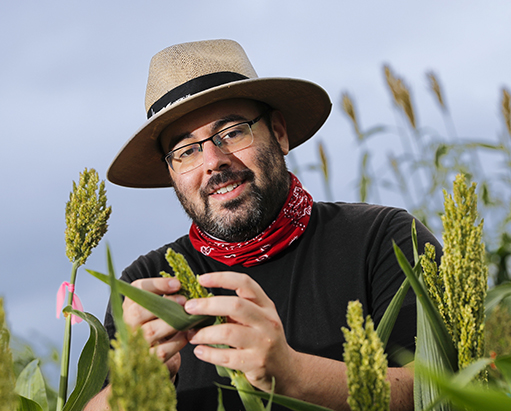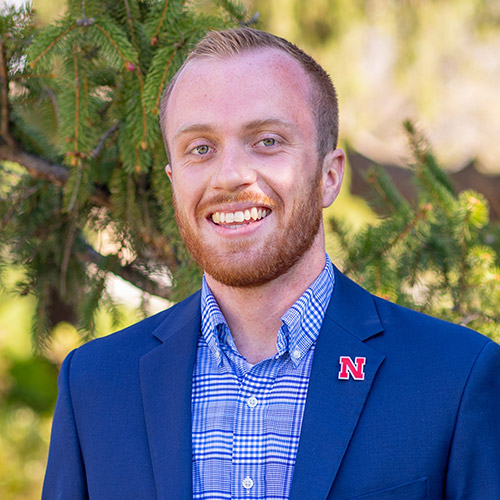
Healthy Crops Thriving in Difficult Environments
Producing Corn and Sorghum with with Less Water, Fertilizer, and Land

As the world’s population continues to rise, researchers are finding new ways to produce greater yields in corn and sorghum working with less water and fertilizer and lower quality agricultural land.
James Schnable, associate professor in the Department of Agronomy and Horticulture at the University of Nebraska–Lincoln determines ways for corn and sorghum to grow and thrive in more difficult environments, in an effort to allow crops to grow on more land while requiring fewer inputs. More difficult environments might include a dry or hot climate that is atypical for the growth of a specific crop.
“Like humans, plants have DNA. We identify the differences within each plant DNA strain and use this information to determine how they respond to different environments,” Schnable said. “The goal is to determine how crops can provide the highest yield in any given environment.”
Specifically, Schnable and his team study sorghum and corn genomics and genetics and use new sensor, robotics, and computer vision technologies to measure how different varieties of corn and sorghum grow and respond to different environments.
Healthy People Need Food
Being a healthy human means eating proper nutrients provided through safe and reliable resources within the agricultural sector. Schnable said food needs to be produced regularly to keep people healthy.
“If people do not have enough food, they will not be healthy,” Schnable said. “If a person is not able to eat enough calories, none of the rest matters. Once people have enough calories, the next priority is the right balance of nutrients.”
Fertilizer Impact on Health
The use of fertilizer, such as nitrogen, impacts human health as well, Schnable said. For many farmers, after the cost of buying seed itself, nitrogen fertilizer is the second largest cost of production.
Yet, Schnable said one challenge farmers face is that the amount of nitrogen fertilizer a given field will require to reach its maximum yield potential varies from one year to the next.
For example, the cost of being wrong in one direction – applying too much fertilizer – is much smaller than the cost of being wrong in the other – applying too little and missing out on potential yield. As a result, perhaps one third of the total nitrogen fertilizer applied to corn is actually unnecessary, costing farmers money and running off into the water supply. For those living in an agricultural state, too much nitrogen and fertilizer can impact the quality of the water supply. The problem is that without better tools or models, researchers do not know which third of nitrogen fertilizer that is from year to year.
“Too much nitrogen and fertilizer can create excess run off that ends up in water ways and cause poor water quality,” Schnable said. “If this happens, water treatment plants are taxed with removing the extra nitrates before they get into the drinking water supply.”
Growing Crops in Non-Native Lands
Despite corn originating in the warmer climates of Central America and sorghum originating in Africa, both crops are now widely grown in the temperate latitudes of North America.
Schnable’s research explores ways to better adapt these crops to cold weather at the beginning and end of the growing season, guided by the solutions developed by wild relatives of these same crop species, which grow natively in Nebraska, have developed.
“If we can develop varieties of corn or sorghum that can be planted earlier in the spring and grow further into the fall without risk of frost damage, those crops can capture more of the total light that falls on a farmer’s field over the course of a whole year,” Schnable said. “More light captured by photosynthesis means the potential for more total grain from the same number of acres.”
Increasing agricultural productivity in Nebraska and throughout the Midwest is not only good for farmers and the agricultural economy. If more food can be produced from the same amount of plant, it reduces the pressure to bring new acres into production globally. Right now, new agricultural land comes primarily from cutting down the rainforest and increasing acreage in Brazil or Southeast Asia.
Interested in a Career in Agronomy?
Agronomy is a fast-growing industry that has changed drastically in the last 10 years, Schnable said.
“An agronomist or plant breeder learns about plant biology and how plants grow,” Schnable said. “But they also learn statistics, programming, computer vision, and artificial intelligence.”
Those who worked with Schnable have gained such transferable skills where they have not only become plant breeders, but also apply for and get interviewed for jobs at Internet and data science companies.
“The type of research we do in agronomy is becoming more generalizable,” Schnable said. “We have better tools for collecting data, so the industry is now more focused on how to analyze the data and use it effectively.”
For more information about opportunities in the Department of Agronomy and Horticulture, visit https://agronomy.unl.edu/schnable,’’
For more information on Schnable’s work, visit http://schnablelab.org/